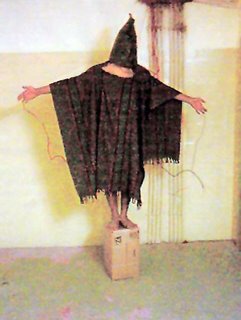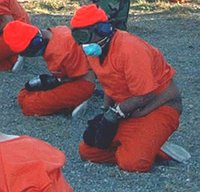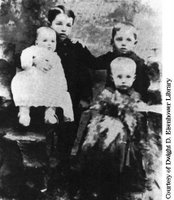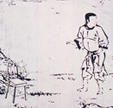A Short Course in Evil
Sleep deprivation can make a victim susceptible to confusion and manipulation. (Alleged assassin James Ray was coerced with sleep deprivation, and it didn’t produce a single mark on his body.) Physical torture may prompt a victim to speak, but it may also stimulate resistance and an urge for revenge. He might lie just to make you stop. Drugs may scramble the brain and render communication meaningless. If you really want to break a man to pieces, you must attack his mind and soul. Psychological torture leaves wounds that don’t heal.
What follows is a summary of the work of Professor Alfred McCoy, the author of A Question of Torture: C.I.A. Interrogation from the Cold War to the War on Terror. He was interviewed by Amy Goodman on Democracy Now, 2/17/2006.
 ALFRED McCOY: Well, if you look at the most famous of photographs from Abu Ghraib, of the Iraqi standing on the box, arms extended with a hood over his head and the fake electrical wires from his arms, okay? In that photograph you can see the entire 50-year history of C.I.A. torture. It's very simple. He's hooded for sensory disorientation, and his arms are extended for self-inflicted pain. And those are the two very simple fundamental C.I.A. techniques, developed at enormous cost.
ALFRED McCOY: Well, if you look at the most famous of photographs from Abu Ghraib, of the Iraqi standing on the box, arms extended with a hood over his head and the fake electrical wires from his arms, okay? In that photograph you can see the entire 50-year history of C.I.A. torture. It's very simple. He's hooded for sensory disorientation, and his arms are extended for self-inflicted pain. And those are the two very simple fundamental C.I.A. techniques, developed at enormous cost.…Dr. Donald O. Hebb of McGill University, a brilliant psychologist, had a contract from the Canadian Defense Research Board, which was a partner with the C.I.A. in this research, and he found that he could induce a state of psychosis in an individual within 48 hours. It didn't take electroshock, truth serum, beating or pain. All he did was have student volunteers sit in a cubicle with goggles, gloves and headphones — earmuffs — so that they were cut off from their senses, and within 48 hours, denied sensory stimulation, they would suffer, first hallucinations, then ultimately breakdown.
 …And if you look at many of those photographs, what do they show? They show people with bags over their heads. If you look at the photographs of the Guantanamo detainees even today, they look exactly like those student volunteers in Dr. Hebb’s original cubicle.
…And if you look at many of those photographs, what do they show? They show people with bags over their heads. If you look at the photographs of the Guantanamo detainees even today, they look exactly like those student volunteers in Dr. Hebb’s original cubicle.Now, then the second major breakthrough that the C.I.A. had came here in New York City at Cornell University Medical Center, where two eminent neurologists under contract from the C.I.A. studied Soviet K.G.B. torture techniques; and they found that the most effective K.G.B. technique was self-inflicted pain. You simply make somebody stand for a day or two. And as they stand — okay, you’re not beating them, they have no resentment — you tell them, “You’re doing this to yourself. Cooperate with us, and you can sit down.” And so, as they stand, what happens is the fluids flow down to the legs, the legs swell, lesions form, they erupt, they separate, hallucinations start, the kidneys shut down.
…[S]everal of those photos you just showed, one of them with a man with a bag on his head, his arms are straight in front of him, people are standing with their arms extended, that’s self-inflicted pain. And the combination of those two techniques — sensory disorientation and self-inflicted pain — is the basis of the C.I.A.’s technique.
Aleksandr Solzhenitsyn wrote about the many forms of physical torture employed in the Soviet prison system; but the purpose of such cruelty usually had little to do with acquiring real information, since the victims were going to be convicted no matter what they said. Torture was employed to make the victims implicate others and sign confessions — or to amuse the interrogators.
Torture twists the perpetrator as well as the victim. Specialist Charles Graner is now in prison because of his actions at abu Ghraib. But before the torture scandal erupted, when he was confronted by a colleague, Graner explained, “The Christian in me says it’s wrong, but the corrections officer [in me] says, ‘I love to make a grown man piss on himself.’”
Torture techniques were refined at Guantanamo with the addition of psychologists who would participate in interrogations and identify the fears and phobias of individual prisoners. Something very like that was described by George Orwell in his great, dystopian novel 1984. The protagonist, Winston Smith, had a fear of rats. He was finally broken when his head was confined in a small cage and his tormentor was about to release a rat into the cage.
When most people imagine torture, they envision fingernails ripped out, electrodes attached to genitals, or good old-fashioned beatings. They don’t really know how fine the line is between sanity and madness; they can’t conceive of prisoners so bent and crushed that they will inflict more pain on themselves than their captors will. But that happened at abu Ghraib. A newly disclosed video shows a victim confined in a canvas bag chained to a wall. His head alone is free as he rocks back and forth, smashing his forehead against the wall.
McCOY: Look, at the start of the war on terror, the Bush administration ordered torture. President Bush said right on September 11, 2001, when he addressed the nation, “I don't care what the international lawyers say. We’re going to kick some ass.” Those were his words, and then it was up to his legal advisors in the White House and the Justice Department to translate his otherwise unlawful orders into legal directives…
They dithered with the definition of “severe” pain, deciding that severe meant “just short of death.” They insisted that torture was bound up with the intent of the perpetrator. If the torturer is seeking information, then he is not committing torture. They inserted a provision in the McCain anti-torture legislation permitting a long-discredited line of defense — if the torturer believes he is following a lawful order, he is not culpable. He’s just following orders.
Finally, in an amendment to the McCain bill, the administration declared that for the purposes of the act, Guantanamo is not part of the United States.
And that, dear reader, is how evil becomes law in a “democracy.” McCain’s bill to prohibit torture became a law to protect torturers. George Bush, Junior can declare anyone a suspect. The suspect can be held indefinitely without charges at a military facility outside the country. We can do anything we want to him. The suspect can be tried by a secret, military court and summarily executed.
You say that doesn’t sound right? Why do you hate America so much?
____________________
Labels: Alfred McCoy, Central Intelligence Agency, Democracy Now, George Orwell, George W. Bush, Guantanamo, John McCain, torture



